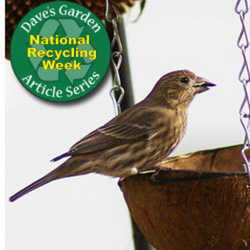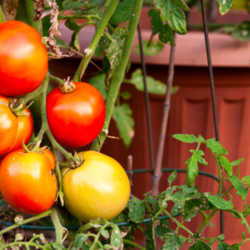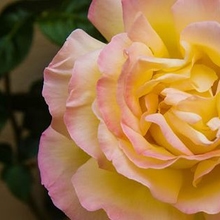|
|
| Virgin and Child by Andrea della Robbia |
Della Robbia refers to an artistic style that was characteristic of art produced by the fifteenth century Italian sculptor Luca della Robbia (1400-1482) and other members of his family. As a decorative element in borders, their artwork incorporated various fruits, usually oranges, apples, pears, and grapes. This fruit motif eventually found its way into live arrangements, primarily garlands and wreaths. Such creations became known simply as "della Robbia."
In the U.S. della Robbia found expression in the Colonial Revival movement of the early 20th Century. An article in a 1926 issue of House Beautiful, for example, states: "Of late years, besides the staple wreaths of plain greens to which we have long been accustomed, the holiday's emblems have blossomed forth--or perhaps we should say fruited forth--with richness of color produced by the use of either natural or artificial fruit as an embellishment. This idea was undoubtedly suggested by the gorgeous Italian carvings and terra cottas of the Renaissance..."
Perhaps the most familiar expression of della Robbia today is found in Williamsburg, Virginia, during the holiday season. In the late 1930s, Mrs. Louise Fisher was in charge of flowers and Christmas decorations in Williamsburg and hit upon the idea of incorporating fresh fruit into the ordinary evergreen wreaths and swags of past Christmases, à la the Italian della Robbia artwork. Until that time, della Robbia decoration was limited primarily to well-to-do families. So popular was this new Williamsburg decorating style that visitors by the thousands flocked there with cameras in hand, snapping photos to use back home to craft their own della Robbia creations. In the succeeding decades, this della Robbia craze spawned dozens of how-to books, workshops, videos, and television demonstrations. The art form remains popular today.
I have to confess that several years ago I was smitten with della Robbia myself. Rather than work with wreaths, roping, or swags, I decided to create a table centerpiece instead (see result at top right of article above). Here is how I did it:
| Tools I Used |
 |
 |
 |
 |
| Drill |
Glue gun |
Hammer |
Pencil and scissors |
 |
 |
 |
 |
| Portable jigsaw |
Stapler |
Tape measure |
Wire cutter pliers |
|
|
 |
 |
 |
 |
Wood: 5 pieces pine; 1 piece
1/2" plywood* |
Window screen |
Corrugated cardboard (at
least 15" square) |
Finishing nails (2.5" long)
and string |
|
|
|
|
|
| Wood screws (1.25" long) |
Floral stem wire (18 gauge) |
Short-needled evergreen
sprigs |
Fresh Fruit |
|
*Pine: 1.5 X 1.5" square; plywood at least 15" square
| Step 1 | Gather tools and materials |
|
All materials I used for the basic arrangement are recycled, except for the fruit. Once the centerpiece begins to deteriorate, I'll recycle the fruit as well, feeding it to the birds--either by simply setting the complete arrangement outside or by cutting fruit up and putting it in a feeder . The wood came from scraps left over from prior remodeling projects, the old window screen from our 109-year-old home, the cardboard from various shipments I've received, the finishing nails and screws from an old centerpiece arrangement, the floral stem wire from prior decorative projects, and the Fraser Fir greens from trimmings at the base of this year's Christmas tree.
If you need to purchase items, you can find the first five in any home improvement store. Floral stem wire is available at most florist shops, greens are stocked at most garden centers at this time of year, and the fruit is available at your favorite market or supermarket.
|
| Step 2 | Prepare materials |
|
Cut four of the five 1.5" X 1.5" wood pieces to a length of 18.5". You can do this at home if you have a hand-, table-, or electric hand saw, but home improvement stores and lumber yards will generally cut the wood to size for you if you buy it there. Cut the remaining piece to a length of 17.5". Next, cut one end of each of the 18.5' pieces at an angle as illustrated in the on the right-hand image of the graphic at left below. To make your guideline for the cut, measure downward 4.5" from the top end along the right-hand edge of the piece and make a pencil mark at the right-hand edge. Take one of the other wood pieces or a ruler and place it at the top of the left-hand edge and align it with the pencil mark you made. Draw the line along the edge of the ruler or wood piece. Cut along the line with a saw or have a salesperson cut it for you at the store. Repeat for each of the three remaining pieces.
Find the approximate center of your piece of plywood and mark it with a pencil. Measure from that point to each of the edges of the plywood to make sure that you've got at least 15" of wood from the center to the edge. With a hammer, pound a nail into the center spot you marked. Cut a piece of string to a length of about 18" and fold it in half. Tie the two ends together so that the resulting loop is about 7.5" long. Slip the loop over the nail and insert the pencil in the loop. Move the pencil toward the edge of the wood until the string is taut. Keep the string taut and move the pencil forward. You are now drawing a 15" circle on the wood. Remove the nail. With a portable jigsaw, cut out the circle. Using as a guide one of the wood pieces you cut earlier (the middle piece in the illustration below), draw a line through the center hole of the wood circle, so that it bisects the circle. Draw another bisecting line perpendicular to it (see illustration below).


Using your wooden circle as a pattern, place it on the cardboard and trace around it with the pencil. Cut the circle out of the cardboard with a sturdy pair of scissors or kitchen shears.
Cut four pieces of screen to size with the wire cutter pliers, using the measurements in the illustration at right.
NOTE: For larger versions of the illustrations, click HERE.
|
| Step 3 | Assemble materials |
|
Drill a hole into the center of one end of the 17.5" wood piece. The hole should be somewhat smaller than the diameter of the screw shaft. Insert one of the screws into the hole made by the nail on the plywood circle. Using the appropriate screwdriver bit in the drill, drive the screw into the hole so that the tip just barely comes out on the other side. Place the circle atop the 17.5" piece of wood so that the screw tip fits into the hole you made with the drill. Drive the screw into the piece. Turn the result upright, taking care to support the wood piece.
Take each of the four 18.5" pieces, placing them on your work surface so that the angled end faces down, and hammer finishing nails into the top side of each piece. Slant the nails slightly upward as you hammer. The nails should penetrate the wood almost to the bottom side of the piece. (If you're concerned that the wood might split when you hammer in the nails, drill a small hole for each nail first.) Hammer at least four nails into each piece, placing them where you might want to position a piece of fruit. If there are unused nails once you've positioned the fruit, you can simply cover them with greens or with other decorations such as pine cones.
Next, make sure that the wood piece in the center of the circle is positioned so that each side faces one of the circle's four lines. It will be the column that supports the four tapered pieces (see illustration below). Attach the tapered ends of the four pieces to the center support with screws, drilling a small hole for each screw first. The non-tapered end of each piece should rest at the outer edge of the circle, centered on the line that runs from the center of the circle to the outer edge. Drill holes and affix the ends with srcews. The basic form for the arrangement is now complete.
 |
 |
Taking each one of the screen pieces in turn, attach them to the form with the stapler. Position the narrow top of the screen at the top of the form so that it sticks out over the top about 3/4" and that the left- and right-hand sides run down the middle of the tapered pieces. There should be enough screen at the bottom, so that you can tuck it under the circle and staple it underneath. Attach the overlapping top of the screen to the top of the form. Work your way down the form, attaching first the left-hand side of the screen and then moving over to the next tapered wood piece to attach the right-hand side. Wherever you encounter nails, cut a small slit in the screen with the pliers and slip the screen over the nail. After all the screens are attached, hammer a nail in upright position into the top of the form, lay the form on its side, and attach the cardboard circle to the bottom of the wood circle. This covers the raw ends of the screen so that they won't catch on a tablecloth or mar the surface of a table.
|
| Step 4 | Decorate form |
|
Attach fruit to the form by impaling it on the nails in any pattern you find pleasing. Once the fruit is in place, you can begin filling in with greens, starting at the top of the form and working toward the base. It's important to use greens with small needles (or leaves) so that they don't overpower the fruit. Attach sprigs of greens with floral wire pins cut to size from the stem wire with the wire cutter pliers. Cut stem wire into 3" or so pieces. Bend each piece in half to form a pin. Position the pin over the bottom end of the evergreen sprig and push the pin down onto the sprig and into the screen to secure it. Overlap sprigs to hide pins and create a fuller appearance to the arrangement. To fill in with greens over the wood supports, use the glue gun to affix them to the screen.
You can leave your arrangement plain (see photo at top right of article) or decorate it with anything that strikes your fancy. I've decorated this particular arrangement with holiday ribbons (below center) and later decided to add some small pine cones, juniper berries, and small bird houses as well (below right). The bird houses came with stems attached (called "picks"), so all I had to do was push the stem into the screen and bend it so that the house was in an upright position. I attached the ribbon with floral wire pins and the pine cones and juniper berries with the glue gun.
 |
 |
 |
| Almost complete (Enlarge photo) |
With ribbon added (Enlarge photo) |
Adding bird houses, juniper berries and
pine cones (Enlarge photo) |
|
|
A note about Styrofoam (polystyrene): It's tempting to use a large Styrofoam cone, because it's so much easier than building the somewhat complex form I've just described. I've found that some cones are unstable. Having too small a base to support the weight of the fruit, they become top-heavy and have a tendency to topple. Heavy fruit on the end of a nail also needs good support, which Styrofoam doesn't always provide. My concern is that at some point the support may fail, causing the fruit to tumble from the arrangement. And, it's very difficult to recycle used Styrofoam cones in the U.S. The form I've described is very sturdy and stable and can be used over and over for many years to come.
|
|
Questions? Comments? Please scroll down to the form below. I enjoy hearing from my readers!
Click here for a text only version of this article
|
 |
|
|










































